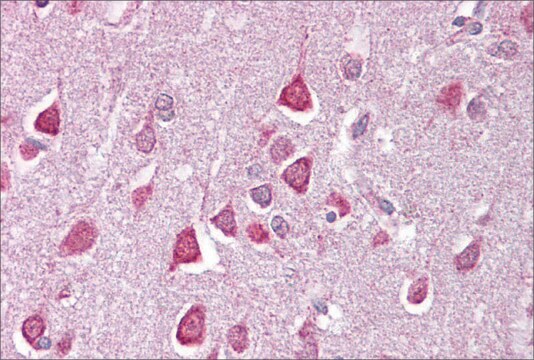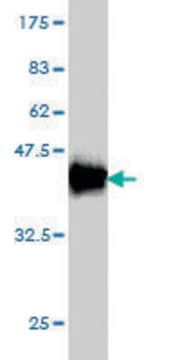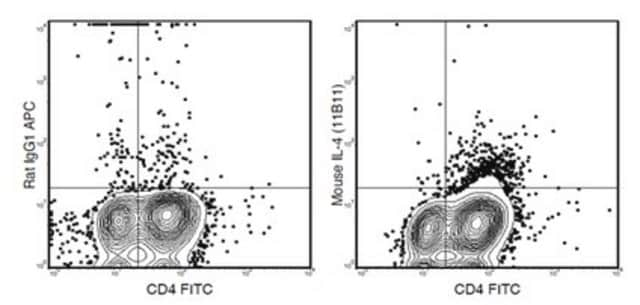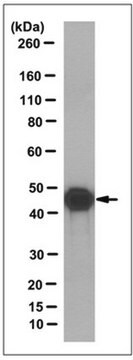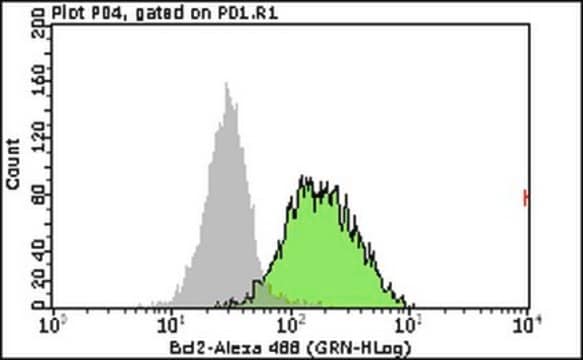MABF1033
Anti-CCRL2 (Mouse) Antibody, clone BZ2E3
clone BZ2E3, from rat
Sinónimos:
C-C chemokine receptor-like 2, Chemokine receptor CCR11, G-protein coupled beta chemokine receptor, L-CCR, Lipopolysaccharide-inducible C-C chemokine receptor
About This Item
Productos recomendados
biological source
rat
Quality Level
antibody form
purified antibody
antibody product type
primary antibodies
clone
BZ2E3, monoclonal
species reactivity
mouse
should not react with
human
technique(s)
flow cytometry: suitable
isotype
IgG2aκ
NCBI accession no.
UniProt accession no.
shipped in
ambient
target post-translational modification
unmodified
Gene Information
mouse ... Ccrl2(54199)
General description
Specificity
Immunogen
Application
Flow Cytometry Analysis: A representative lot immunostained liver and lung CD31+/CD146+ endothelial cells from wild-type, but not Ccrl2-/- mice. Intraperitoneal LPS injection prior to cells isolation upregulated surface CCRL2 staining on liver and lung CD31+/CD146+ endothelial cells (Monnier, J., et al. (2012). J. Immunol. 189(2):956-967).
Flow Cytometry Analysis: A representative lot detected cytokines-induced CCRL2 expression on the surface of bEND.3 mouse endothelioma cells. IKKbeta inhibitor BAY (11 7082) and/or JAK-1 inhibitor (sc-204021) inhibited cytokines-induced CCRL2 expression (Monnier, J., et al. (2012). J. Immunol. 189(2):956-967).
Flow Cytometry Analysis: A representative lot immunostained L1.2 mouse pre-B lymphoma cells expressing transfected mCCRL2, but not untransfected L1.2 or L1.2 transfectants expressing mCMKLR1, huCMKLR1, mCRTH2, huCCRL2, or mCCR10, nor non-CCRL2-expressing mouse blood cells. Chemerin, but not CCL2, blocked clone BZ2E3 staining of CCRL2-positive mouse peritoneal exudate cells (Zabel, B.A., et al. (2008). J. Exp. Med. 205(10):2207-2220).
Inflammation & Immunology
Quality
Isotyping Analysis: The identity of this monoclonal antibody is confirmed by isotyping test to be rat IgG2a .
Target description
Physical form
Storage and Stability
Other Notes
Disclaimer
¿No encuentra el producto adecuado?
Pruebe nuestro Herramienta de selección de productos.
Storage Class
12 - Non Combustible Liquids
wgk_germany
WGK 1
Certificados de análisis (COA)
Busque Certificados de análisis (COA) introduciendo el número de lote del producto. Los números de lote se encuentran en la etiqueta del producto después de las palabras «Lot» o «Batch»
¿Ya tiene este producto?
Encuentre la documentación para los productos que ha comprado recientemente en la Biblioteca de documentos.
Nuestro equipo de científicos tiene experiencia en todas las áreas de investigación: Ciencias de la vida, Ciencia de los materiales, Síntesis química, Cromatografía, Analítica y muchas otras.
Póngase en contacto con el Servicio técnico

